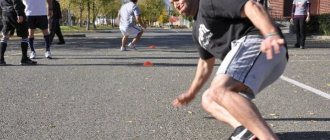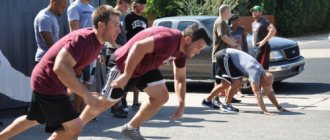Shuttle running is a type of short distance jogging in both directions, several times. The length of the segment may vary, but, as a rule, does not exceed 80-120 meters. Shuttle running is included in the mandatory training program for football players, basketball players, hockey players, handball players and other types of sports. It is important for those sports that require excellent coordination, agility and speed. This type of running is also common in some fitness areas, including CrossFit.
Features of shuttle running
Shuttle running has a number of differences from interval running or jogging. This technique creates a slightly different load. Shuttle Features:
- Start at maximum speed in the first seconds.
- Turning in the opposite direction with minimal loss of speed.
- Touching the floor or carrying objects when reaching the turning point.
- Change of direction – 180 degrees.
- Development of maximum speed after the last turn.
- Repeatedly covering a short distance.
- No need for a large area.
Types of shuttle running
Shuttle running - what is it? This is a test of the general physical fitness of any average person of different age categories. Also, by measuring the speed of the shuttle race, the physical fitness of military personnel is checked during control and final tests.
The length of the classic distance of this run is 100 meters. The runner covers this section of the path several times, each time changing direction in the opposite direction. At the end points of the path there are control points that the runner must touch without losing time. The main task of a marathon runner is to run the specified distance as many times as required in the shortest possible time.
In addition to the classic hundred-meter race, there are 3 more common types of shuttle running distances:
- 3×10 – this distance is intended to test the physical fitness of primary school students, and it is also included in the complex for passing the GTO. A race participant must run a 10-meter segment 3 times, each time changing direction to the opposite.
- 4x9 – this type of shuttle run is used to test the physical fitness of middle school students.
- 10x10 – this type of shuttle running is used to test the physical fitness of law enforcement officers (MoD, Ministry of Internal Affairs, Ministry of Emergency Situations).
In some cases, the competitor must run the path first with his face forward, then turn around and return with his back. The requirement for fixing control points may also change. Depending on the rules of the competition, the runner must touch, run around the point, grab the pin, etc. High intensity interval training system. Burn fat again
This type of running belongs to one of the subtypes of sprint races. However, the main difference is that when performing a shuttle run, you need to make a turn. Experienced athletes prefer to run straight distance races rather than shuttle races. This is due to the fact that it is much easier to maintain speed on straight distances. When performing shuttle races, the runner has to sharply change the trajectory of movement during a turn. When covering a short distance you have to quickly pick up speed, brake, turn around and pick up maximum speed again to finish. Therefore, before taking part in shuttle running competitions, mandatory preparation is required. Only a trained runner is able to cover the distance in a short time and without causing physical injury to himself.
What physical quality does long running develop?
Special endurance is a person’s ability to demonstrate endurance in a particular sport. ... An excellent means of developing endurance is regular long-distance running.
Interesting materials:
What did the home front workers do? What did they do in Buchenwald? What did the priests do in Egypt? What to do to avoid waking up at night? What to do after completing the desk audit? What to do in case of a landslide briefly? What to do if freon leaks from the refrigerator? What to do with the Magic Book? What to do with an electronic plane ticket? What to do with the puppy?
The benefits and harms of shuttle running
When performing a shuttle run, the athlete must quickly develop speed in order to cover a short distance as quickly as possible. In this case, the marathon runner must make a U-turn and return back to the starting point, also maintaining a good pace, and so on a certain number of times. Shuttle running helps maintain balance and develop coordination. During a race, a large number of different muscles function.
Also, this type of running perfectly develops the development of resistance to different paces and its regular changes. The athlete develops body motor skills, explosive leg power and strength qualities.
Concluding the benefits of shuttle running, we can highlight the following advantages:
- improved coordination;
- balance, improvement of the vestibular apparatus;
- power loads;
- muscle motility;
- dexterity;
- endurance;
In addition, the human body receives such positive changes as:
- benefits for the cardiovascular system;
- weight loss;
- cleansing the body of toxins;
- improved blood flow;
- relieving fatigue.
Despite all the possible advantages, shuttle running remains a traumatic activity. Therefore, you should always remember to follow safety rules. This is especially true for beginners.
Shuttle running technique
Shuttle running is considered a traumatic activity, so you should warm up your muscles well before performing it. You also need to choose stable shoes that do not slip.
Competitions in this type of running must be held on areas with a flat and hard surface.
For any type of shuttle race, the technical aspects are standard:
- Start;
At the start, the athlete places his supporting leg in front, shifting the center of gravity forward. The body is slightly inclined, but the back remains straight. It is recommended to concentrate as much as possible and get ready for a quick start.
- Movement along the distance;
The movement begins after the command “March!” The runner covers the distance and touches the control point. To maintain high speed, it is recommended to land on the ball of your foot, this recommendation is suitable for short runs.
- U-turn.
The difference between shuttle running and any other is that at the end of the route the marathon runner must make a 180° turn. After this, he must pick up speed again to cover the rest of the distance. It is recommended to take a stopping step before turning. To do this, you need to turn the foot of the front leg in the direction of the turn, and turn the body in the same direction. After this, you need to push off with your front foot.
During the race, it is recommended to breathe in a two-by-two pattern. This means that you need to take 2 steps while inhaling and 2 steps while exhaling.
Initial position
Classic starting position: we place the supporting leg forward, trying to keep the entire center of gravity above it. The quadriceps of the supporting leg is tense, like a spring, the body is tilted slightly forward, the back is straight, we keep our hands at the level of the ribs. The start should be as explosive and fast as possible in order to overcome the first segment in the minimum time. For a truly explosive start, we need strong and well-developed legs, so pay more attention to exercises that develop explosive power in the quadriceps: barbell squats with a pause at the bottom, sumo deadlifts, box jumps, jump squats, etc.
Another option for the starting position is a low start:
Running speed
During the race itself, we need maximum speed. To do this, after each step you should not land on your entire foot, but only on your toe. To develop this skill, replace your standard cardio with jumping rope, then the Lisfranc joint will adapt to constantly landing on your toes, and shuttle running will be much easier.
U-turn
At the end of each segment you need to make a 180 degree turn. To do this, you need to sharply reduce the speed and take a stopping step, turning the foot of your front leg 90 degrees in the direction of the turn - this movement will slow you down, but will not completely extinguish the inertia.
Start
Starting position – standing. One leg is located in front, the center of gravity of the body falls on it. One arm is pulled back and helps at the start, moving the body weight further forward.
At the start command, the body leans even further forward, the pushing leg does its job, while the other prepares to take over the relay. You may find recommendations to run on your toes to increase speed. You can start in a way that is convenient for you. The main thing is good speed.
You have started, now your main task is to reach maximum speed in the first couple of seconds.
Acceleration
In the last stretch, you need to squeeze the maximum out of your body and make one last explosive acceleration, without thinking that you will soon need to stop, you must continue to increase the speed right until the finish line.
You can see a video of the shuttle race below. It very clearly shows the technique of performing shuttle running:
Special attention to the finish
Such “ragged” sections of the distance do not allow the athlete to accelerate at full strength, because when running short distances of 100 - 200 meters, athletes spend the first 10-15 meters accelerating, during which the body position gradually takes on a vertical position, and steps are almost 1/3 shorter than a normal mid-distance stride.
At the same time, when performing this discipline, no matter how many segments need to be overcome, the last segment is important from the point of view of the final result. This is explained by the fact that when passing it, it is no longer necessary to reduce speed and make a U-turn. Experienced athletes take advantage of this feature, paying great attention to the last part of their training, from the moment of turning around to crossing the finish line.
Here you need to look at literally every meter more carefully:
- when turning, the most effective body position is assumed, from which the athlete must make a jerk with maximum acceleration;
- the first 2-3 steps are made a little short, the initial acceleration is complemented by acceleration, the body is tilted forward, the head is tilted forward, the arms are moved sharply along the body, without straightening the arm at the elbow or throwing the hand back;
- after gaining the necessary acceleration, the body is gradually straightened and the head is raised, but without throwing it up, the steps are taken large, the movements of the arms allow the hands to be thrown back with the arms straightened at the elbows;
- the maximum pace of movement must be maintained so that when crossing the finish line the athlete continues to move at the maximum pace, and braking begins only after 7-10 steps after crossing the finish line.
Technical details
To understand how to improve your training, listen to your body and experience: all the secrets are in mastering the technique and yourself! But both indicators can be developed. If this is your first training, then pay due attention to the lead-in exercises for training posture and turn: 5, 10 and 15 meters. They need to be done at an average pace with short stops when turning. During real running, there is no need to stop there - this will reduce the speed and impede inertia.
Also, you shouldn’t immediately strive to run exactly 10/10. Start with lower yardage and repetitions: 4 times 9 meters. You can then increase the distance to 15 and 20 meters, maintaining 4 repetitions. And only after a month and a half, move on to the full-fledged 10/10 option.
After completion, do not stop abruptly - walk or jog at an average pace for a few more minutes so that the blood is distributed correctly. Then you can stop and drink some water.
Common mistakes
When learning the technique of performing the 10x10 shuttle run, many beginning athletes encounter the following problems that prevent them from getting the most out of this exercise:
- Incorrect load distribution. If you run 10 equal sections of shuttle running, your endurance will usually run out after the first half. To avoid this, you need to start running at medium intensity, trying to increase the speed with each segment, using the explosive power of the leg muscles.
- Load volume too large. Don't go overboard with your training volume when it comes to high-intensity cardio like this, especially if you suffer from various types of cardiovascular diseases. You will most likely end up doing more harm than good.
- Stopping too slowly before turning. There is no need to reduce your running speed in order to turn around calmly; you need to turn around in one movement, sharply turning your leg 90 degrees - this way you will maintain the force of inertia and not reduce your speed to zero.
- Incorrect breathing rate. While performing the shuttle run, you should breathe in the “2-2” mode, taking two steps while inhaling and two steps while exhaling. You should breathe only through your nose.
- Don't forget to warm up properly, as shuttle running involves engaging a huge number of muscles, joints and ligaments.
Benefit
This method of training is useful in that it helps to increase the explosive strength of the leg muscles, improve the functioning of the entire cardiovascular system, develop coordination and strength endurance. Shuttle running standards are used to assess the physical fitness of not only athletes, but also employees of various law enforcement agencies.
Usually shuttle running is carried out over short distances from 10 to 30 meters, but in rare cases the distance can reach 100 meters. Due to its many-sided benefits, this exercise has gained popularity in fitness, crossfit, various martial arts, and is also included in the mandatory physical training program in schools, specialized academies under government agencies and in the Armed Forces of the Russian Federation.
Today we will figure out how to do shuttle running correctly, as well as what are the practical benefits of this exercise on the human body from the point of view of the all-round development of an athlete.
Standards for shuttle running
Residents of Russia and the CIS countries have been familiar with the concept of GTO since Soviet times. The abbreviation stood for “Ready for Labor and Defense.”
In 2014, the president signed a decree that revived this system again.
The GTO complex is aimed at developing physical culture among the population. It improves the physical fitness of residents and develops sports in the country.
The GTO includes such a discipline as shuttle running at a distance of 3x10 meters.
Standards for passing the GTO standards in shuttle running for schoolchildren
| Age group | For boys | For girls | ||||
| Bronze badge | Silver badge | Gold badge | Bronze badge | Silver badge | Gold badge | |
| from 6 to 8 years | 10,3 | 10,0 | 9,2 | 10,6 | 10,4 | 9,5 |
| from 9 to 10 years | 9,6 | 9,3 | 8,5 | 9,9 | 9,5 | 8,7 |
| from 11 to 12 years | 9,0 | 8,7 | 7,9 | 9,4 | 9,1 | 8,2 |
| from 13 to 15 years | 8,1 | 7,8 | 7,2 | 9,0 | 8,8 | 8,0 |
| from 16 to 17 years old | 7,9 | 7,6 | 6,9 | 8,9 | 8,7 | 7,9 |
Standards for passing the GTO standards in shuttle running for men and women
| Age group | For men | For women | ||||
| Bronze badge | Silver badge | Gold badge | Bronze badge | Silver badge | Gold badge | |
| from 18 to 24 years old | 8,0 | 7,7 | 7,1 | 9,0 | 8,8 | 8,2 |
| from 25 to 29 years old | 8,2 | 7,9 | 7,4 | 9,3 | 9,0 | 8,7 |
Standards for military personnel
The standards and procedure for performing exercise No. 42 “Shuttle run” for military personnel are described in detail in the Manual on Physical Training (NFP-2009). As it became known, starting from 2022, the Ministry of Defense plans to introduce a new Manual, where the Directorate of Physical Training has taken a radical approach to this exercise. It is planned to change the scoring table, and everyone’s question, “Will this exercise be canceled when taking tests,” unfortunately remains unanswered. Only one thing is clear: for military personnel in category 1, the list of exercises is now determined by the inspector.
Rules, distances and standards
Most often, intermediate distances during shuttle running are shuttle running 10x10 meters. The runner must run 10 meters there and back 10 times.
For professional athletes, the range is selected taking into account the athlete’s preparedness and the tasks that must be solved during the training process.
The rules for this type of running cannot be called complicated.:
- on a site without unevenness, 10 meters are measured;
- “Start” and “Finish” are indicated;
- start is made from a high or low position;
- the movement is carried out to the 10 meter mark, which the runner must touch;
- touch is a signal to fulfill the elements of the standard;
- after touching, the sprinter turns around and runs in the opposite direction, touching the line again, he turns around and runs again.
Standards for boys from 6 to 17 years old:
How to start shuttle running
Shuttle running training is carried out at low speeds. Your main task is to teach your body to move in the correct rhythm, feel the speed and show an adequate reaction to its change.
If you start running fast from the first training sessions, you won’t get any special results. First you need to accustom your body to the correct technique, and only then practice it at higher speeds.
Who shouldn't
Such running is a serious load that not everyone can afford. There are some conditions and illnesses where you should not run. These include:
- hypertonic disease;
- ischemic disease;
- serious rhythm disturbances;
- injuries of the musculoskeletal system, as well as anatomical changes: hernia, protrusion, etc.;
- pregnancy and breastfeeding;
- vascular lesions of the arteries and veins of the brain;
- period after stroke and heart attack;
- acute inflammatory process, including infectious;
- uncontrolled bronchial asthma;
- complicated diabetes mellitus;
- severe breathing problems.
If there is reason to suspect any of the above, you should immediately go to the doctor. He will conduct an examination and help you cure the problem in time and adjust your training.
How to improve your results
The correct technique for performing shuttle running alone may not be enough to effectively cover the distance. Of course, technicality is the main key to covering the distance. But to improve the results and safety of classes, it is important to consider the following recommendations:
- Be sure to warm up. Shuttle running is one of the most traumatic types of timed running. Therefore, before covering the distance, perform a quality warm-up that warms up all muscle groups, ligaments and tendons. Stretch muscles make it faster and easier to get into the pace and go the distance better. If you skip this step, you may suffer damage to your calf muscles.
- Exercise regularly. For example, in order to pass school standards for this type of activity, you need to study regularly for at least a month. During this time, the muscles will tone and adapt to the load.
- Stretching the calf muscles. Thanks to proper stretching, good muscle recovery ability, strength and endurance are maintained. To strengthen your legs, be sure to work on their flexibility.
All this will make shuttle running as useful, effective and safe as possible. We invite you to watch a video describing this technique.
Improving results
You can improve your shuttle running results by following a number of recommendations. The following will help optimize your existing base:
- Performing a warm-up aimed at warming up and increasing the elasticity of muscles and ligaments. Ignoring this rule can lead to injury to the calf muscles.
- Regular training.
- Performing stretching. Increases muscle endurance and strength.
Thus, shuttle running develops the skills necessary for various sports. Its benefits are obvious - it makes it possible to increase muscle tone, improve coordination, reduce subcutaneous fat, strengthen the cardiovascular, respiratory systems and the body as a whole.
Training program for beginners
| Week #1 | Week #2 | Week #3 | Week #4 |
| Warm-up – 10 minutes | Warm-up – 10 minutes | Warm-up – 10 minutes | Warm-up – 10 minutes |
| Shuttle run 3x10m. Number of repetitions – 3. Rest – 2 minutes. | Shuttle run 3x10m. Number of repetitions – 3. Rest – 2 minutes. | Shuttle run 4x20m. Number of repetitions – 3. Rest – 2 minutes. | Shuttle run 10x10m. Number of repetitions – 2. Rest – 2 minutes. |
| Stretching exercises. Duration – up to 10 minutes. | Stretching exercises. Duration – up to 10 minutes. | Stretching exercises. Duration – up to 10 minutes. | Stretching exercises. Duration – up to 10 minutes. |
How to run
Shuttle running consists of several phases:
- Warm-up: necessary to prepare the heart, blood vessels, lungs and muscles, should take at least 10-15 minutes. It usually includes simple general strengthening exercises, moderate-intensity running or walking, and in some cases, special running exercises to develop technique.
- Stretching: This can be used to complete the warm-up and the entire workout. In the first case, 2-3 exercises on the muscles of the lower extremities are suitable, and in the latter, you should carefully stretch the entire body.
- Direct running: it consists of circular repetitions - 10 times 10 m with a turn. First come the commands - to start, attention, march. At this time, you need to take the correct posture and group your body for the upcoming load.
You shouldn’t take breaks between laps - they move into each other without stopping, and by the last lap you need to speed up, on the contrary. The technique of execution does not depend on the number of repetitions.
An important trick is to distribute your forces correctly! Don't start running with maximum effort. As practice shows, about 60% of the energy is spent on the last laps, so you need to save yourself for the final push. Each lap occurs with a slight acceleration.
Let's look at all the stages briefly.
Examples of training using shuttle running
Shuttle running can be done both independently and as part of complex training. With its help, you can diversify the program and increase the efficiency of the load. Below are workouts for athletes with different levels of training.
- 200 meter race, 10 push-ups, 3x20 shuttle run. Only 3 cycles.
- Push-ups – 30 times, 20 squats, jumping rope – 60 seconds, shuttle run – 5x10. Three cycles.
- Pull-ups – 30 times, push-ups – 10 reps, 40 push-ups, shuttle run 20x4. 2 cycles.
In this case, the exercises can be supplemented by carrying objects during shuttle running.











